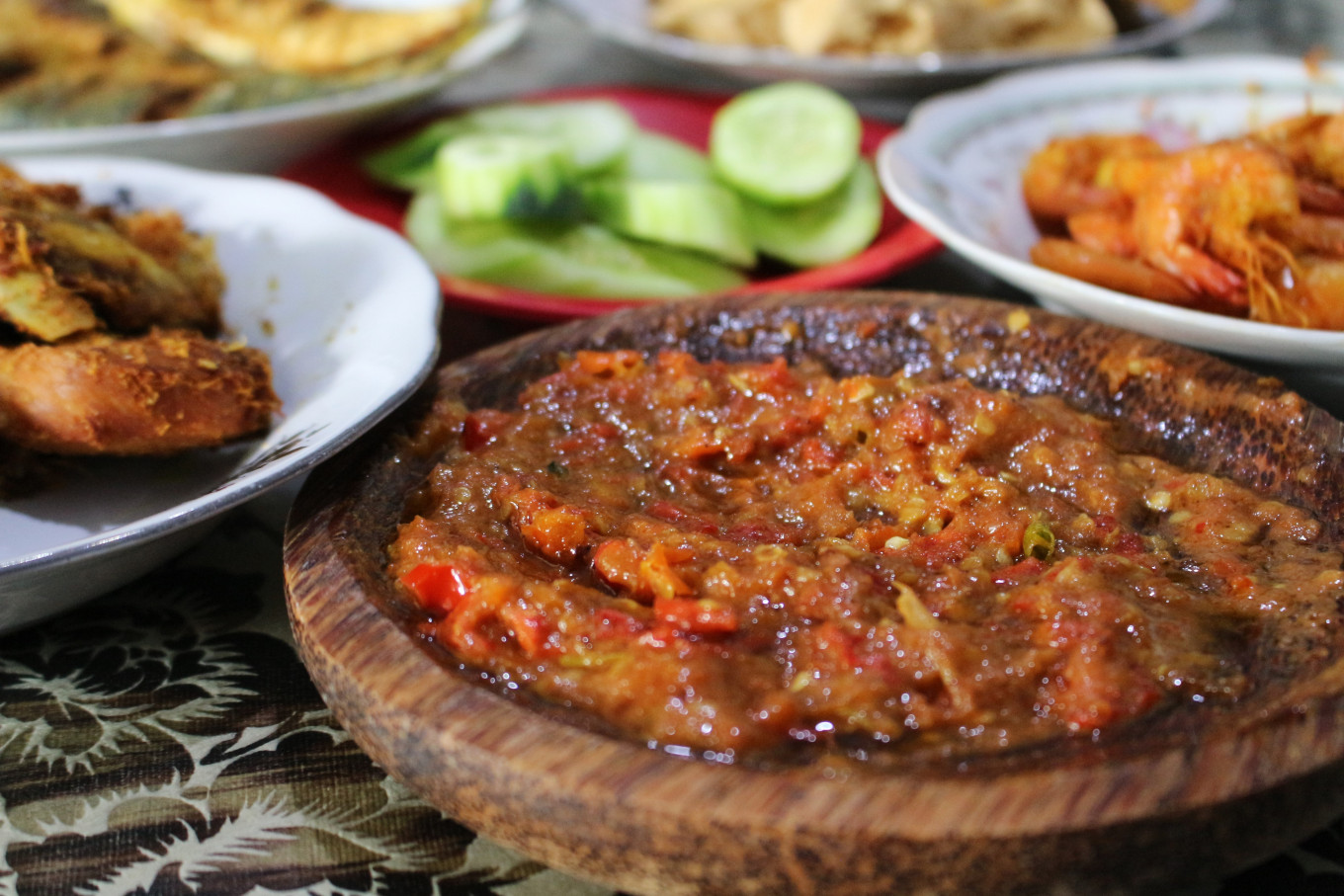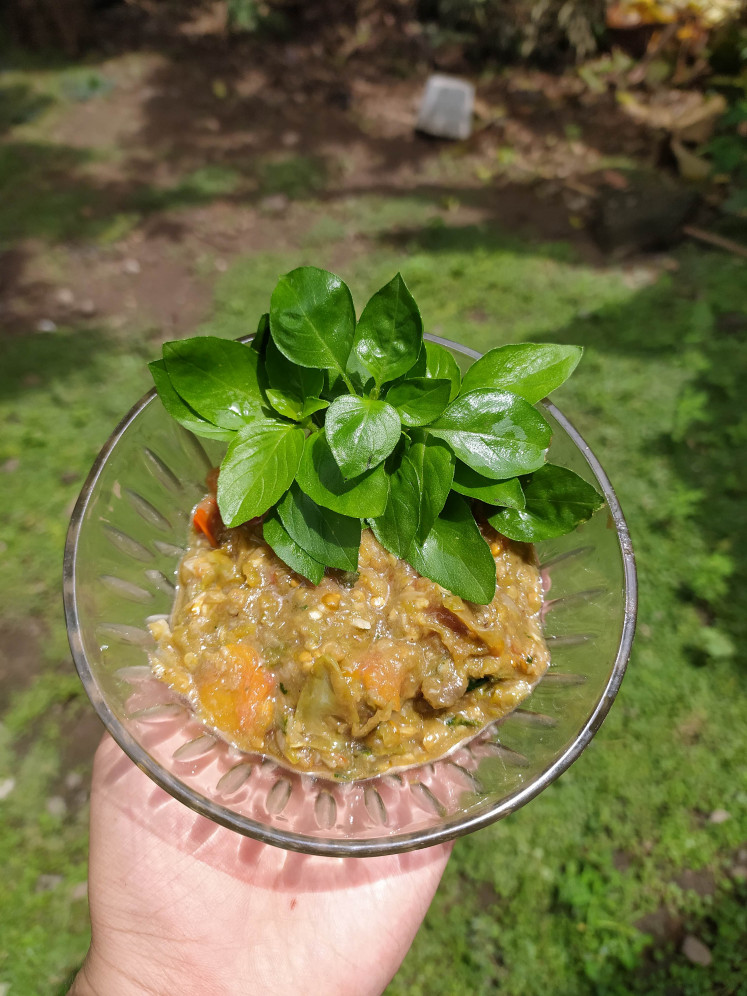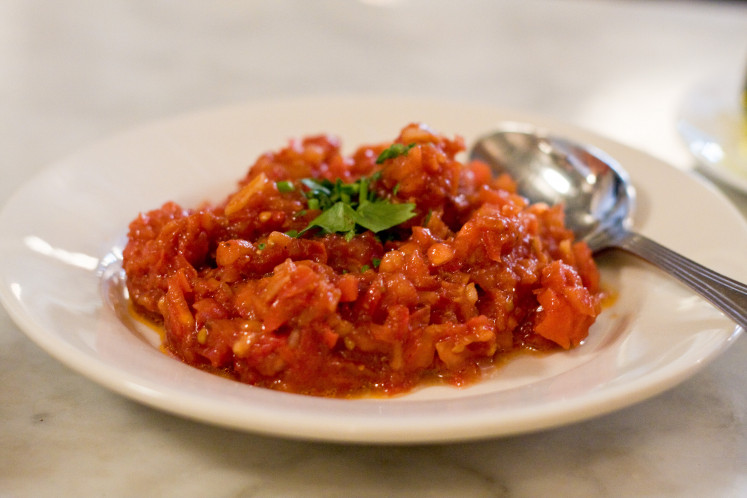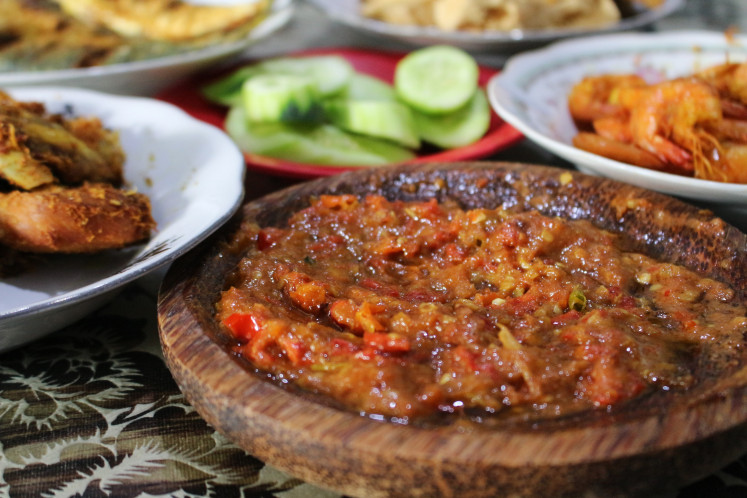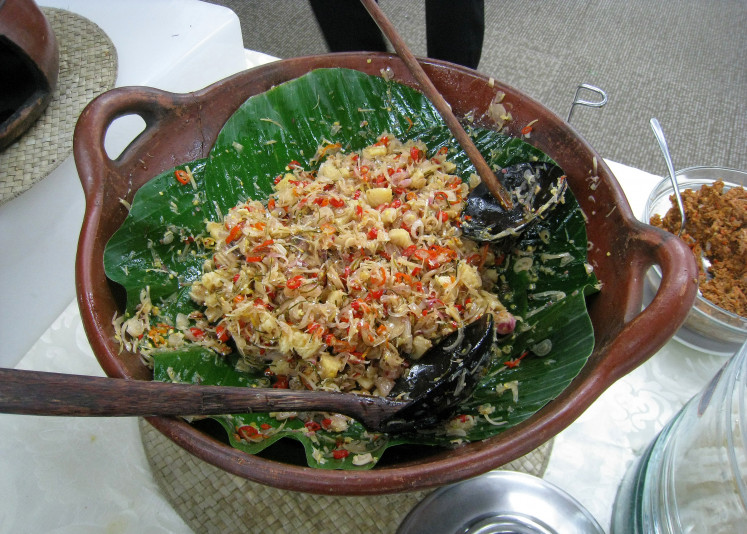Popular Reads
Top Results
Can't find what you're looking for?
View all search resultsPopular Reads
Top Results
Can't find what you're looking for?
View all search resultsTwenties: The endless variety of Indonesian sambal
Many spices are native to Indonesia, and with a lot of ingredients comes a lot of flavor. One iconic condiment that makes use of this bounty is sambal, a spicy sauce or paste produced from chili peppers and other ingredients. Here are 20 popular regional recipes.
Change text size
Gift Premium Articles
to Anyone
T
wenties is a column where contributors offer their top 20 lists of anything and everything of interest, from food and history to pop culture and lifestyle.
Many spices are native to Indonesia, and with a lot of ingredients, comes a lot of flavor. One iconic condiment that makes use of this bounty is sambal, a spicy sauce or paste produced from chili peppers and other ingredients.
Here are some of Indonesia’s most popular sambal recipes to start the ultimate journey of heat.
1. Sambal roa
Sambal roa is made from the roa fish (ballyhoo halfbeak), a type of flying fish. The fish are dried and then cooked with other ingredients, such as chili and shallots. The sambal is paired with dishes such as yellow rice, tinutuan porridge and goroho banana dip in North Sulawesi. And a bowl of sagela porridge in Gorontalo would be incomplete without this spicy, smoky chili sauce.
2. Sambal mangga
Sambal mangga (mango sambal) is one of the country’s most popular chili sauces. The sourness and freshness of the young mango combines with the spiciness of the chili to give this sambal a distinct flavor, while garlic and shrimp paste enhance the experience.
Special ingredients: The Sundanese sambal cibiuk stands out for its aromatic basil leaves. (Wikimedia Commons/Wiwik P) (Wikimedia Commons/Wiwik P)3. Sambal kandas sarai
The Dayak people make a variety of chili sauces, one of which is sambal kandas sarai (lemongrass sambal), which features the herb’s fresh fragrance. This sambal is typically served with grilled or fried ghost catfish, cork fish, catfish or shrimp.
4. Sambal nanas
Aside from mango, pineapple can also be used to provide a fascinating blend of spicy and sour flavors in a chili sauce. Sambal nanas (pineapple sambal) is often paired with fish dishes such as fried or grilled tilapia. The spicy pineapple mixture is also a good addition to the popular nasi kebuli (goat pilaf).
5. Sambal cibiuk
Sambal cibiuk is a traditional chili sauce from Garut, West Java. Green tomatoes and aromatic basil leaves lend the dish a distinctive freshness. This sambal comes in two types: red and green. Both are delectable.
Entry-level spice: Evoking childhood memories for many Indonesians, sambal tomat (tomato sambal) is the tamest of them all. (Wikimedia Commons/Garrett Ziegler) (Wikimedia Commons/Garrett Ziegler)6. Sambal matah
Sambal matah (raw sambal) is frequently served with Balinese delicacies like fried or grilled fish. It is also now used to complement a variety of modern dishes, including fried dory and other fried dishes.
Compulsory condiment: Sambal, in one of its many forms, is a must-have on any Indonesian dining table. (Unsplash/Fahrizal Saugi) (Unsplash/Fahrizal Saugi)7. Sambal terasi
A typical household staple in Indonesia, sambal terasi (shrimp paste sambal) is a popular variant that is eaten throughout Southeast Asia. It made with a fermented shrimp paste.
Spicing it up: Adding tropical fruits, such as mangoes, pineapples or gandaria, to sambal makes it a great complement for seafood. (Wikimedia Commons/Mdsheth1986) (Wikimedia Commons/Mdsheth1986)8. Sambal dabu-dabu
Sambal dabu-dabu is a well-known condiment from Manado, North Sulawesi. Its reputation as a delicacy has spread throughout the archipelago. Red tomatoes, red chilies, cayenne pepper, shallots and lime juice are combined to make it.
9. Sambal Lombok ijo
Padang is known for its green chili sauce, in addition to its spice-rich cuisine. Padang's Sambal Lombok Ijo (Lombok green sambal) is an excellent accompaniment to many Padang dishes, and it is often cooked into the dish itself, such as in lidah sambal ijo (stir fried ox tongue in green sambal).
Variations: Some sambals are mashed, while others have thinly sliced ingredients that are mixed together, such as sambal matah (raw sambal) and sambal embe. (Wikimedia Commons/Gunawan Kartapranata) (Wikimedia Commons/Gunawan Kartapranata)10. Sambal bajak
Sambal bajak (plow sambal) is particularly popular in East Java. It is so named because its spiciness makes those who eat it gasp and sweat as if they have been plowing a field. It looks very similar to sambal terasi, but its flavor is fresher because of the addition of bay leaf.
11. Sambal andaliman
Sambal andaliman is used in Batak cooking. Andaliman itself looks like a peppercorn and is also known as Batak pepper. It has a subtle citrus scent and a sharp spiciness akin to Sichuan pepper.
12. Sambal colo-colo
Sambal colo-colo is a simple chili sauce from Maluku that has a fresher flavor than many other chili sauces because the ingredients are left raw. Lime and basil leaves elevate the aroma, and soy sauce is sometimes included.
13. Sambal luat
Sambal luat is a traditional chili sauce from Kupang, East Nusa Tenggara. It is created with cayenne pepper, basil and lime juice. Sambal luat is typically served with se’i, a traditional Kupang smoked meat dish, usually of beef, pork or chicken.
14. Sambal gandaria
Sambal gandaria highlights the sweet and sour gandaria fruit. The fruit’s flesh produces a viscous liquid with a unique aroma that pairs excellently with chili sauce. Unfortunately, gandaria is becoming increasingly hard to find.
15. Sambal tempoyak
Tempoyak is durian that has been salted and fermented for several days. Mixed with chili paste, it is commonly enjoyed as a side dish by Malay communities in Bengkulu, Palembang, Lampung and Kalimantan. The sour, aromatic paste is also often added to other dishes, such as in pindang tempoyak.
16. Sambal tomat
True to its name, the main ingredient of sambal tomat (tomato sambal) is tomato, perfect for those who like sambal but don’t want it too spicy. The spicy, salty, savory and somewhat sour flavor of sambal tomat distinguishes it from other chili sauces.
[3]
17. Sambal delan
Sambal delan is also known as sambal khampai in Lampung because of the addition of small tomatoes called khampai in the Lampung language. The tomatoes look like cherry tomatoes but are more sour. Chili, salt, shrimp paste and sugar are the other main components of this popular Lampung chili sauce.
18. Sambal rica-rica
In addition to sambal roa, one of Manado's best-known specialties is the very spicy sambal rica-rica. Minahasan herbs and spices, such as lime leaves, lime juice, lemongrass, tomatoes, ginger and onions, are added to Sambal rica-rica, making it more aromatic.
19. Sambal tumpang
Sambal tumpang is a popular processed sauce from Central and East Java. Literally “overlapping” sambal, this condiment has a savory, spicy flavor and is made from tempe semangit (fermented tempeh). It is typically served in nasi tumpang and nasi pecel.
20. Sambal embe
Sambal embe is a traditional Balinese chili sauce with shallots, green chilies, limes, vegetable oil and shrimp paste as its essential components. Instead of being mashed together, these ingredients are sliced thinly and mixed together. The sauce shines when it is combined with warm rice and veggies.
ohmg

